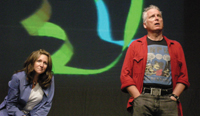Vol.
30 No. 1
January-February 2008
“Chemistry is Beautiful”—A Report on the Opening Plenary Lecture by Roald Hoffmann
by Neil Gussman
“Chemistry has so much to be proud of,” said chemist, poet, playwright, and polymath Roald Hoffmann in his opening plenary lecture at the IUPAC Congress in Torino. Hoffmann’s talk, which began with chemistry then gave a glimpse of his views on philosophy and human nature, preceded a staging of his latest play, Should’ve.
Hoffmann, the 1981 Nobel laureate in chemistry, credits the chemical sciences with providing spiritual as well as material progress to humanity. “Knowledge of genetics, of the cosmos, of the color of cornflowers” is just part of an “incredible gain in knowledge” through chemistry, Hoffmann said. He noted that the knowledge that chemistry gave the world supplied “improvements for some, but not for all.”
Hoffmann then turned from chemistry to its effect on society. “People are not happier,” Hoffmann said, referring to people in cultures that have the benefits of modern science, “and many do not praise technology” because “people are not happy by nature.” That comment started a small buzz in the audience. Hoffmann went on to say that the divide between those in the sciences and the wider population exists because “people are not machines. They are wonderful, vexing beings. Science cannot understand people.”
Speaking of how little the general public understands chemistry, he said, “Half of the nitrogen atoms in me are from a chemical reactor through the Haber-Bosch process.” It was clear from the buzz and nods that this fact was news to many—even in an audience more familiar with chemistry than just about any similar-sized group on the planet. Since it went into use in Germany at the beginning of World War I, the Haber-Bosch process has been the source of an ever-larger fraction of the nitrogen available for biological processes.
Hoffmann then addressed the perception of chemistry among the wider public. “In the past 50 years, pollution has changed from normal entropy to a sin,” he asserted. The public perception of chemistry descended from a mid-20th-century source of innovation and products to make life better to a source of pollution and a threat to health. He then proposed a three-point plan to reconnect chemistry with the world at large. Chemistry leaders should:
- accept human nature
- introduce ethical and ecological concerns in all chemical training
- reawaken the primary motive of science, to meliorate the human condition
 |
| On stage in Torino, Michele Brown as Katie Wertheim and Robert Clinton as Stefan Cardenas in the first production of Should’ve.
For more about Roald Hoffmann’s Should’ve, see May-June 2007 CI, pp. 4–7. |
Hoffmann turned 70 in 2007. Born in 1937, his early life was marked by one of the worst crimes in human history. “The feeling of being dealt with unfairly causes real pain,” he said, yet he added, “I remain an optimist despite or because of surviving the Holocaust.”
Next he turned to the effect the free market can have on ethics, saying, “Market conditions alone do not provide motivation for ethical production decisions.” He cited the choice between producing malaria drugs and Viagra as an instance of where the free market can lead.
As he brought his talk to an end Hoffmann connected creativity and responsibility to describe the tension central to his latest play. He takes creativity as a given of human life: “As we create—we cannot help creating—we have a responsibility to ask about final use.”
He then took a seat with the audience and watched the premiere of his third play, which follows the family of a scientist who committed suicide as they deal with the consequences and the meaning of his death and the choices they made because of him.
Hoffmann remained in Torino for much of the week that followed, participating in discussions and public events during the biennial congress. He is very well known for saying “Chemistry is beautiful.” Through plays and poetry, he brings his own perception of beauty to audiences who might otherwise never be able to see what he sees in chemistry.
Neil Gussman <[email protected]> works at the Chemical Heritage Foundation (CHF) www.chemheritage.org. In Torino, he represented CHF and attended the meeting of the IUPAC Committee on Chemistry Education (see p. 16 in print). CHF shares common goals with, and is an Associated Organization of, IUPAC.
Page last modified 7 January 2008.
Copyright © 2003-2008 International Union of Pure and Applied Chemistry.
Questions regarding the website, please contact [email protected] |